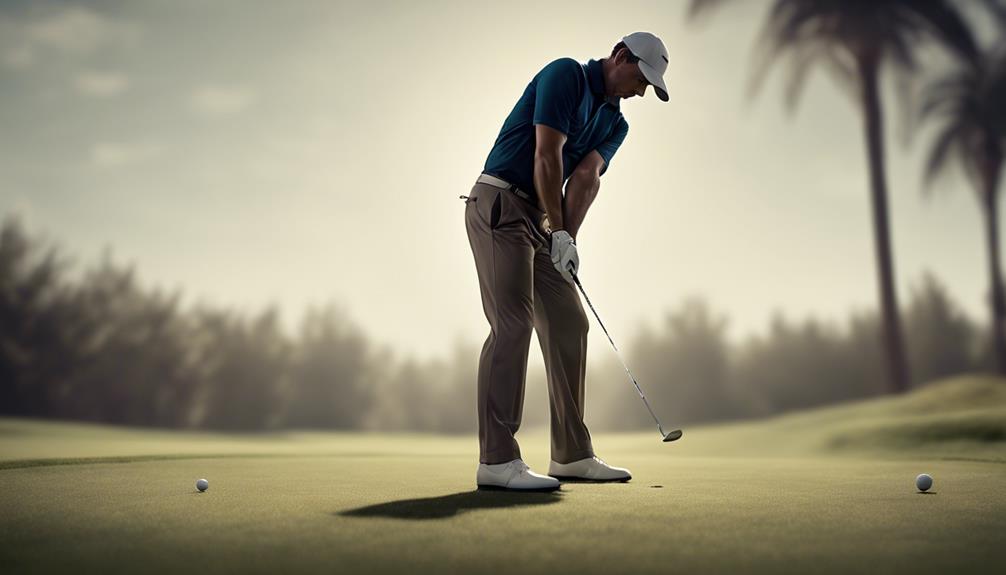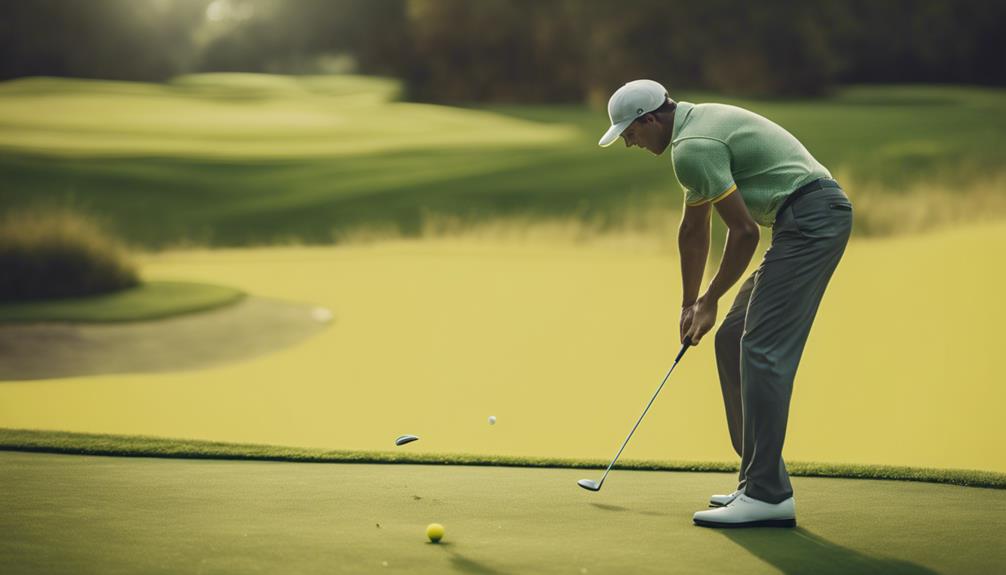- 7 Top Flite Golf Clubs XL for Improved Performance - September 28, 2024
- Top Flite Golf Clubs: Top 5 Reasons to Choose Them - September 28, 2024
- Top 3 Golf Club Fitters for a Perfect Swing - September 28, 2024
You're about to reveal the secret to a consistently powerful and accurate golf drive by mastering seven key steps that will transform your game. First, perfect your stance with shoulder-width distance and weight evenly distributed on both feet. Next, grip the club with confidence, ensuring proper hand positioning and grip pressure. Initiate the backswing sequence by focusing on a connected takeaway and hinging your hips. Then, shift to the downswing phase by rotating your shoulders and maintaining weight distribution. As you generate power through hip rotation, make contact with the ball, and finally, follow through for consistency. Now, get ready to elevate your game to the next level.
Key Takeaways
- Maintain a consistent stance and grip, with feet shoulder-width apart and weight evenly distributed, to ensure a stable foundation for the swing.
- Initiate the swing sequence with a connected takeaway, hinging hips and uncocking wrists for a powerful backswing, while maintaining consistent posture and weight distribution.
- Rotate shoulders around the spine to generate torque and power, achieving correct rotation for a competitive edge, and focusing on shoulder flexibility for swing speed.
- Drive the clubface squarely into the ball, targeting the center, and transfer weight from back foot to front foot for better contact and power generation.
- Complete a smooth, balanced follow-through, rotating the body, and maintaining balance and control throughout the swing, with the club releasing naturally and pointing towards the target.
Mastering the Perfect Stance
How do you set yourself up for a powerful golf drive, one that will leave your opponents in awe? It starts with mastering the perfect stance.
As you step onto the golf course, you want to feel confident and prepared to take on the challenge of the game. To do this, maintain a shoulder-width distance between your feet, ensuring you're stable and balanced. Position your feet parallel to the target line, so you're aligned with the direction you want the ball to go.
Distribute your weight evenly on both feet, keeping your foundation solid and strong. A slight knee flex will promote stability and flexibility during the swing motion, allowing you to generate more power and control. Finally, keep your spine straight and tilt your upper body slightly forward, optimizing your body positioning for a powerful drive.
Gripping the Club With Confidence
With your stance perfected, you're now ready to focus on gripping the club with confidence, as a solid grip is the key to releasing a powerful and accurate drive. A confident grip guarantees proper alignment, maintaining control and stability throughout the swing motion. It's crucial to find the best grip pressure, allowing for a smooth transfer of power from your body to the club.
Here are the key elements to focus on for a confident grip:
- Proper hand positioning: Confirm your hands are placed correctly on the grip, with your fingers wrapping around it uniformly, promoting stability and control.
- Correct grip pressure: Apply the right amount of pressure, avoiding squeezing the club too tightly or loosely, allowing for efficient power transfer.
- Finger placement: Position your fingers to maintain a consistent grip, with your thumbs pointing down towards the ground.
- Wrist alignment: Keep your wrists firm and aligned, avoiding any twisting or bending that can throw off your swing.
- Clubface control: Ensure the clubface remains square, with the club moving on a consistent plane, resulting in a more accurate drive.
Initiating the Backswing Sequence

Now that you've got a solid grip, it's time to focus on initiating the backswing sequence.
You'll want to prioritize a connected takeaway, where your arms, hands, and body work in harmony to set the club on the correct path.
Backswing Fundamentals Explained
You initiate the backswing sequence by hinging your hips and uncocking your wrists, allowing your shoulders to rotate away from the target while maintaining a stable lower body. This fundamental movement sets the stage for a powerful and consistent golf drive.
To master the backswing fundamentals, focus on:
- Maintaining a consistent backswing posture, with your spine angle and weight distribution unchanged
- Rotating your shoulders efficiently, avoiding any twisting or swaying motions
- Creating coil by hinging your hips and uncocking your wrists, generating torque and leverage
- Keeping your upper body connected, with your arms and shoulders working in sync
- Avoiding any loss of posture or swaying during the backswing, ensuring a smooth shift to the downswing
Proper Shoulder Turn Technique
Rotate your shoulders around your spine, initiating the backswing sequence by turning away from the target and setting up the swing.
This proper shoulder turn technique is essential for creating torque and power in your golf drive.
As you rotate, focus on maintaining shoulder flexibility, allowing your upper body to coil and generate swing power.
A correct rotation will also help you achieve a faster swing speed, giving you a competitive edge on the course.
Transitioning to the Downswing Phase
As you prepare to unleash the full force of your golf swing, shifting your weight from your back foot to your front foot marks the critical shift to the downswing phase. This weight transfer is vital, as it sets the stage for a strong and controlled downswing.
To execute this changeover flawlessly, focus on the following key elements:
- Initiate the downswing with your lower body, allowing your hips and legs to lead the movement
- Maintain a smooth motion, avoiding any jerky or sudden movements
- Keep your weight transferring smoothly from back to front, generating power and momentum
- Ensure proper sequence, where your lower body leads and your upper body follows
- Stay grounded and balanced, with your feet firmly planted on the ground
Generating Power Through Hip Rotation

Now that you've mastered the shift to the downswing phase, it's time to reveal the secret to generating raw power in your golf drive: hip rotation.
You'll learn how to utilize the energy stored in your lower body and direct it into a blazing clubhead speed, resulting in longer, more consistent drives.
Let's delve into the mechanics of hip rotation, the keys to efficient energy transfer, and how to integrate it all for a more forceful swing.
Hip Rotation Explained
By harnessing the power of your hips, you can access a more efficient energy transfer that propels the clubhead to remarkable speeds. Hip rotation is the key to accessing a more powerful golf swing, and it's vital to understand how to engage your hips correctly.
Here's how to master hip rotation:
- Flexibility is pivotal: Focus on hip flexibility tips to increase your range of motion and reduce restrictions in your swing.
- Stability is essential: Understand the importance of hip stability to maintain a consistent swing plane and prevent energy leaks.
- Drills for mastery: Incorporate hip rotation drills into your practice routine to develop muscle memory and improve your overall technique.
- Torque generation: Learn to generate torque through proper hip rotation, which will notably increase clubhead speed and momentum.
- Consistency and accuracy: Mastering hip rotation will lead to greater consistency and accuracy in your drives, giving you a competitive edge on the course.
Power Generation Secrets
You'll acquire a significant boost in power by focusing on the precise sequence of hip movement during your swing, which involves a synchronized rotation of your pelvis, hips, and lower body. As you master this sequence, you'll unleash the full potential of your lower body, generating more torque and energy transfer to the club. This, in turn, will result in increased clubhead speed and longer drives down the fairway.
To optimize your hip rotation, incorporate specific drills into your practice routine. Try rotating your hips in a slow, controlled motion, keeping your upper body still. Focus on generating power from your core and lower body, rather than relying on your arms and shoulders.
Additionally, practice rotating your hips in both directions, first clockwise and then counterclockwise, to develop a smooth and efficient motion.
Efficient Energy Transfer
As you rotate your hips in a synchronized motion, you're effectively releasing the potential for efficient energy transfer from your lower body to the club, resulting in a significant increase in swing speed and power. This vital step in the golf swing is often overlooked, but it's essential for maximizing efficiency and enhancing performance.
Here's what's happening during efficient energy transfer:
- Your hips act as a pivot point, allowing your upper body to rotate and generate torque.
- The energy stored in your lower body is released, propelling the clubhead towards the ball.
- Your core muscles engage, stabilizing your body and maintaining balance throughout the swing.
- The sequence of hip rotation is critical, as it sets the tone for the rest of the swing.
- By mastering hip rotation, you'll improve your accuracy and consistency, leading to more confident shots off the tee.
Making Contact With the Ball
Drive the clubface squarely into the ball by targeting the center, where best contact is achieved. This is essential for ideal impact accuracy and a consistent ball trajectory. To ensure this, focus on aligning the clubface square to the target at impact, as even a slight misalignment can result in a wayward shot.
Here's a breakdown of the key factors to keep in mind for making perfect contact:
| Factor | Description | Tips |
|---|---|---|
| Clubface Alignment | Align the clubface square to the target | Focus on the center of the clubface |
| Weight Transfer | Transfer weight from back foot to front foot | Maintain balance and rotate body |
| Body Rotation | Rotate body to generate power and control | Keep shoulders and hips in sync |
Following Through for Consistency

To guarantee a consistent golf drive, focus on maintaining a smooth, balanced follow-through. This involves your arms extending and your body rotating, culminating in a full finish with the club pointing directly at the target. This essential step secures proper club release and rotation, leading to consistent ball striking.
Here's what a well-executed follow-through looks like:
- Your arms extend fully, with the club releasing naturally from your hands.
- Your body rotates, maintaining balance and control throughout the swing sequence.
- You complete the follow-through motion, leading to a full finish with the club pointing towards the target.
- Your weight transfers smoothly to your left foot (for right-handed golfers), indicating a balanced swing.
- Your eyes remain focused on the target, securing a consistent alignment and direction.
Frequently Asked Questions
How Do You Hit a Perfect Golf Drive?
To hit a perfect golf drive, you'll master a proper stance, ensuring balance and stability, then grasp the club with a correct grip, and finally, execute a smooth follow-through technique to release a powerful, accurate shot.
How Long Does It Take to Get a Perfect Golf Swing?
You'll reach a perfect golf swing by maintaining practice consistency, focusing on technique refinement, and tracking progress. With dedication, you'll see improvements in a few weeks, but mastery may take several months to a year.
How Do You Hit a Golf Ball Perfect Every Time?
"You're probably thinking, 'Consistency is impossible, I'll never hit it perfect every time.' But, with precise grip adjustments, proper body alignment, and a smooth swing tempo, you'll master the art of striking the ball flawlessly, every single time."
How Do You Hit a Perfect Straight Drive?
You'll hit a perfect straight drive by maintaining a proper grip, positioning the ball just forward of center, and efficiently transferring power from your core to the clubhead, resulting in a consistent, accurate shot.
Conclusion
With each swing, synchronize your silky smooth sequence, harnessing hip horsepower to hammer the ball with precision.
Perfect your pace, pivoting effortlessly from backswing to downswing, as your club cracks the air with confidence.
Consistency is key, so freeze your finish, fixing your form in muscle memory.
Now, step up to the tee, armed with a flawless formula, and release a drive that's truly dynamite.




